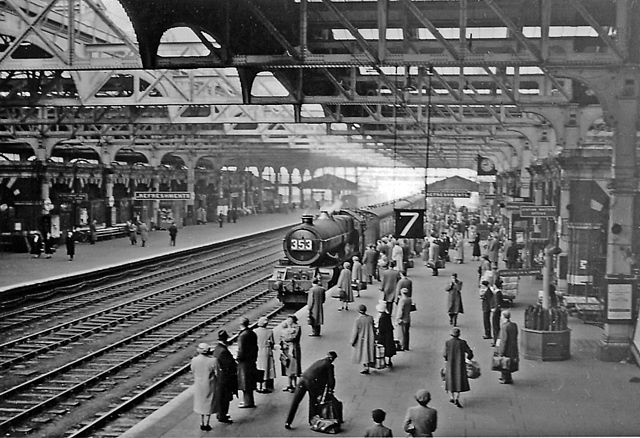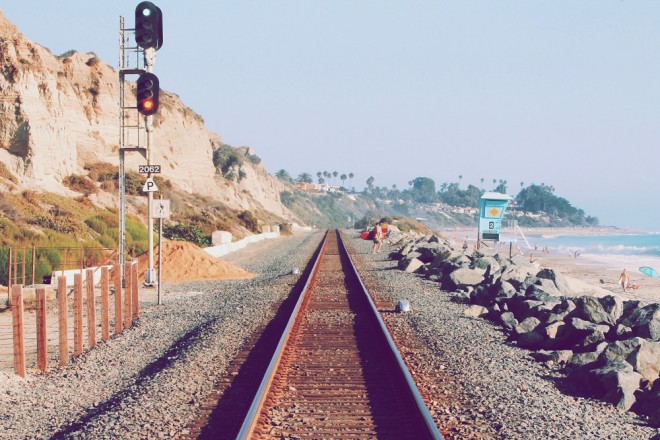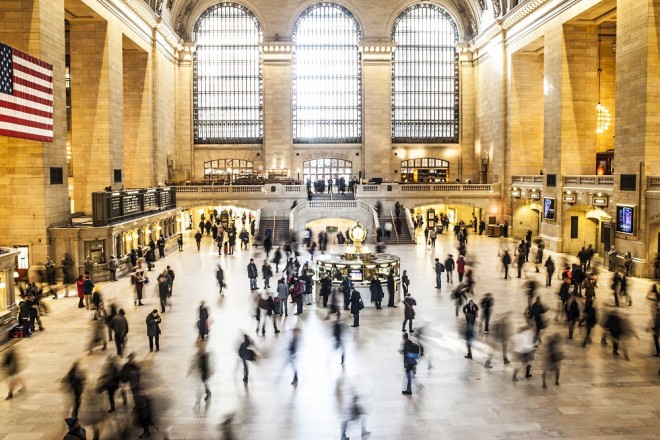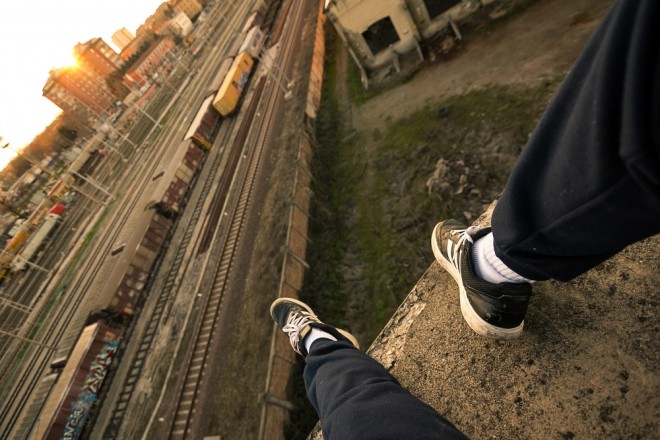My first long-distance train trip was a bit of a surreal experience.
Headed from Avignon to Paris, the TGV (high-speed train) was the best combination of a fast and affordable journey I could find and one that gave me an intimate glimpse into the lives of the other passengers and the microcosm of French life they reflected.
Fellow travelers treated the train as a mobile home and a dining room, as out of copious bags came baguettes, pâté, and bottles of wine. Card games were held with enthusiasm, small dogs yipped, and accordion music played.
By the time I had arrived in Paris, I had seen how French people interacted with each other, their unguarded enjoyment of their families, and their ability to turn the mundane into a party. That, or I’d unwittingly been cast as an extra in a movie about French culture.
Travelling by long-distance train appeals to the practical traveller and the wanderluster.
Convenient, affordable, frequent, and often headed to a multitude of destinations not serviced by airports or good roads, trains are the ideal mode of transportation for the adventurous female traveller.
More affordable than airfare, more comfortable than buses, and a lot safer than hitchhiking, train travel offers a host of benefits to the woman who wants to see the world, not skip over it.
What are the best things about train travel?
Flexibility, for one thing. You have the option of cheaper tickets, whether you buy them in advance or at the last minute. Choosing train travel also makes it far easier and affordable to break your trip into multiple destinations and stopovers. You have the option of bringing your own food and beverages aboard or purchasing them en route on many trains, there’s more room to move around than on a bus or plane, and the ability to bring multiple bags without having to pay for each one of them is beyond convenient.
Train travel is also a great, safe option for those who are afraid of flying or can’t fly for health reasons or pregnancy. If you’re concerned about your privacy or your safety, many trains offer semi-private or private compartments, including women-only sleeper compartments, for those looking for quieter journeys or safer overnight options.
And did we mention the beauty? Trains are one of the most picturesque ways to travel. A train journey winds you alongside beaches, across flower-strewn fields, over mountain passes, through historic town centres, past suburban homes, and brings you intimately into contact with a country’s people and culture. As most train stations are centrally located (and, in newer cities, often built around a railway station or terminus), train travel allows you to see the architecture, backyards, homes, and lifestyles of locals as you pass through their towns on your way to a destination.
Women and trains — going places throughout history.

With benefits like those above, it’s not surprising that surveys by both the United States and British governments find that women use trains more frequently than men for short-haul travel and in equal numbers for long-distance travel.
But did you know that trains have frequently been promoted as a safe and convenient form of transportation for women since the late 1800s?
Even before today’s women-only sleeper compartments and subway cars, trains were linked with female-friendly travel. Whether as a transportation method for a hardworking 19th-century husband to send his wife safely on vacation; to appeal to the matched-baggage owning ‘bright young thing,’ looking for a luxurious and independent way to see the world in the 1920s; or to prevent today’s women from experiencing sexual harassment on their way to work, trains have been catering to female audiences since shortly after the first trains in England started carrying passengers in the mid-1800s.
Women travelers were expected to act demurely on these journeys, especially if travelling unescorted. There were many etiquette rules for women travelers, who were recommended to carry only one bag, avoid wearing attention-getting clothes or jewelry, and always ignore opportunistic gentlemen who might seek intimacies or simple acquaintance.
However, many famous female explorers and travellers likely flouted these rules when they utilized trains to explore the world and write their travel memoirs.
Journalist Nellie Bly, who set out to beat the fictional world record set by Phileas Fogg in Jules Verne’s Around the World in 80 Days, utilized both trains and steamer boats in 1889 to circumnavigate the globe in only 72 days and later published a book about her experience.
Harriet Chalmers Adams was another fearless woman, who was actually known as ‘America’s greatest female explorer’ during the mid-20th century. She used train journeys as subject matter for her travel books and National Geographic articles, including the trans-Andean railroad between Argentina and Chile.
Don’t speed by these 9 tips to make your next train trip your best one yet.

Women of old recognized the benefits of train travel and utilized the rails to see the world. It turns out, train travel is still a fantastic way to watch the countryside go by, zip quickly between cities, and get to know your fellow travelers.
And while even basic train travel can be more practical and appealing than other forms of transportation, there are a few extra tricks any woman can use to make her train trip the best it can be:
1. Book your ticket in advance.
If the reasons above haven’t already convinced you to book your next trip by train, the savings will. Booking your ticket in advance could save you a significant amount of money, especially when it comes to long-distance trips.
2. Consider a rail pass.
According to RailEurope® (our sponsor for tonight’s #Wanderful Twitter chat), opting for a rail pass can save you money if you plan to take several train trips — RailEurope recommends four or more. However, if you only plan to take one or two trains, stick to point-to-point tickets to maximize your budget.
3. Time out your journey.

The time when you travel will affect both the price you pay for a ticket and your comfort. Rush-hour trains into and out of major cities usually cost more and, according to RailEurope, tend to sell out more quickly than off-hour trains.
4. Aim for a window seat.
This especially goes for longer daytime trips for which you can book your seat. Sit back, relax, and enjoy the views!
5. Skip a seat with a table…
…unless you plan to work during the whole journey. The facing seats mean you have less legroom than a traditional seat.
6. Get the middle bunk in a sleeper.
It’s a safer height than the top bunk, but it keeps you from getting trapped in the bottom bunk by everyone else’s luggage.
7. Never carry more luggage than you can keep your eye on.
Trains rarely have luggage carriages anymore, which means your luggage will be unsecured for the whole trip. Pro: You can access it all. Con: You’ll want to keep it in your eyesight.
8. Bring water and snacks for long-haul trips.
Food on trains is usually available but can be expensive. Candy, trail-mix, sealable drinks, fruit, and anything else that won’t make much of a mess if you drop it are all great options. And with unlimited baggage, you could pack a whole lunch sack full!
9. Study the route of your train to know what stop is prior to yours.
Trains rarely stop for long at stations, so you should start preparing to disembark once the train leaves the station before your stop.
A train journey can be the ultimate way to observe — and participate in — a culture while travelling. More than a mere form of transportation or a means to an end, train travel often creates a sense of shared camaraderie. Whether it’s sharing an overnight sleeper car and road stories with other women, sharing snacks and reminiscences with an elderly couple on a long-haul train, or merely chatting with your seatmate about hidden gems to explore at your destination, train travel often leaves you looking forward to more time riding the rails instead of simply being grateful to reach your destination.

Interested in learning more about traveling by train? Want to share your awesome experience riding the rails like the female explorers of yore? Share with us in the comments, and join us as we talk train travel and take Twitter by storm TONIGHT, March 8. We’ll be joined by RailEurope, the ultimate online destination for ensuring your trip is all that you want it to be from start to finish to everything in between.
Make Twitter your next stop tonight at 9 PM EST, as we chat all things women and rail travel with RailEurope under #Wanderful!
Featured image by Austin Smart on Unsplash.































